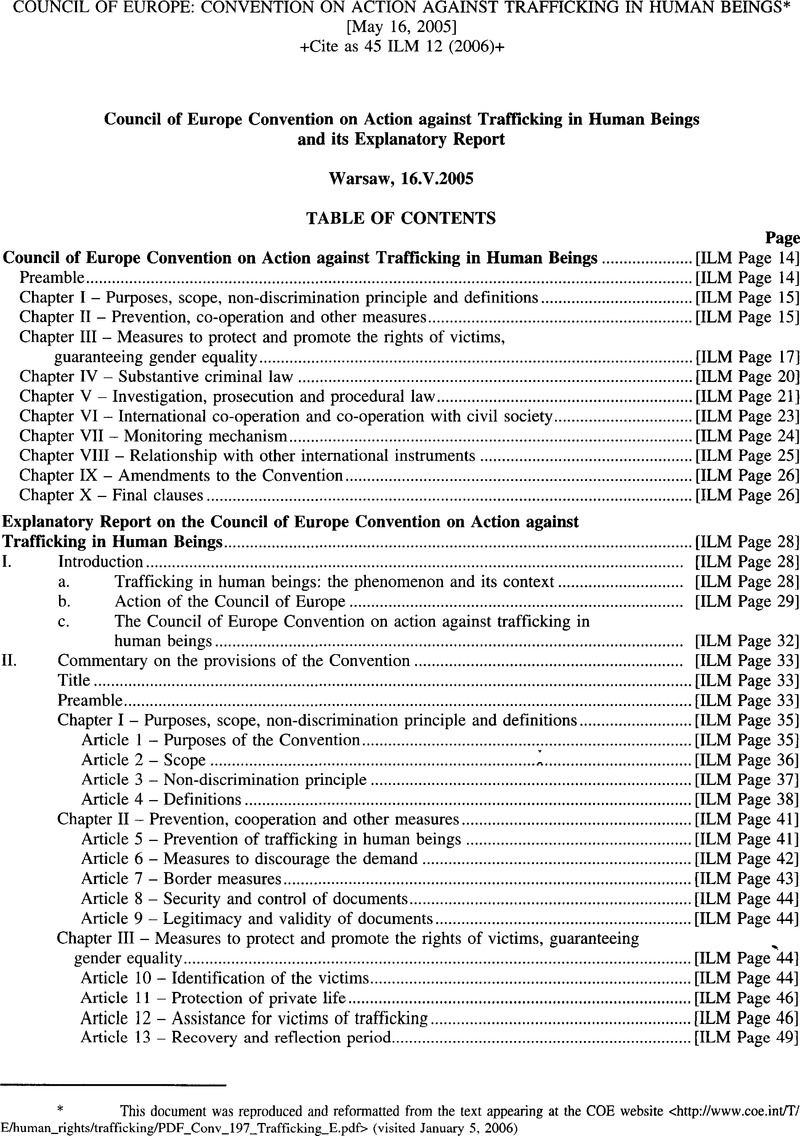Article contents
Council of Europe: Convention on Action Against Trafficking in Human Beings
Published online by Cambridge University Press: 27 February 2017
Abstract

- Type
- Treaties and Agreements
- Information
- Copyright
- Copyright © American Society of International Law 2006
References
Endnotes
* This document was reproduced and reformatted from the text appearing at the COE website <http://www.coe.int/T/E/human_rights/trafficking/PDF_Conv_197_Trafficking_E.pdf> (visited January 5, 2006).
1 1991 Strasbourg seminar organised by the Steering Committee for Equality between Women and Men (CDEG) on Action against traffic in women, considered as a violation of human rights and human dignity.
2 Plan of action against traffic in women (doc. EG (96) 2) by Ms Michele HIRSCH (Belgium).
3 For example, an International seminar on action against trafficking in human beings for the purpose of sexual exploitation: the role of NGOs (Strasbourg, June 1998) and a Workshop on good and bad practices with regard to media portrayal of women, with reference to trafficking in human beings for sexual exploitation (Strasbourg, September 1998).
4 Within the framework of the Stability Pact for South-Eastern Europe, the Council of Europe organised an International seminar on “Coordinated action against trafficking in human beings in South-Eastern Europe: towards a regional action plan”. At the invitation of the Greek authorities, the seminar took place in Athens from 29 June to 1 July 2000. It was organised in partnership with the United Nations High Commissioner for Human Rights, OSCE/ODIHR and the International Organisation for Migration (IOM), and with the support of Japan.
5 A seminar on “Coordinated action against trafficking in human beings in the South Caucasus: towards a regional action plan” was held in Tbilisi on 6 and 7 November 2002.
6 EG-S-NT (2002) 9 Fin.
7 European Convention on the exercise of children's rights of 25 January 1996 [ETS No. 160] (in relation to the 1989 UN Convention on the rights of the child).
8 Convention on Laundering, Search, Seizure and Confiscation of Proceeds of Crime of 1990 [ETS No.141] (in relation to the UN Convention against Illicit Traffic in Narcotic Drugs and Psychotropic substances of 1988); Council of Europe Agreement of 1995 on illicit traffic by sea, implementing Article 17 of the United Nations Convention against illicit traffic in narcotic drugs and psychotropic substances of 1995 [ETS No. 156].
9 See, inter alia, UN Docs: CCPR/CO/79/LVA, dated 06/11/ 2003 and A/53/38/rev. 1, respectively. See also, The Permanent Council of the OSCE's Decision No 557: Action Plan to Combat Trafficking in Human Beings, 24 July 2003 and the Budapest Declaration on Public Health and Trafficking in Human Beings of 19-21 March 2003. See also, the second paragraph of the Preamble to the SAARC Convention on Preventing and Combating Trafficking in Women and Children for Prostitution.
10 Eur. Court HR, X and Y v. The Netherlands judgement of 26 March 1985, Series A no. 91, paragraph 23
11 Eur. Court HR, Young James and Websters v. The United Kingdom judgement of 13 August 1981, Series A, no. 44, paragraph 49.
12 See, inter alia, the following judgments: Eur. Court HR, A v. The United Kingdom judgement of 23 September 1998, Reports of Judgments and Decisions 1998-VI, paragraph 22; Eur. Court HR, Z and others v. The United Kingdom judgement of 10 May 2001, Reports of Judgments and Decisions 2001-V, paragraph 73; Eur. Court HR, M.C. v. Bulgaria judgement of 4 December 2003; application no. 39272/98.
13 Article 3(2) of the United Nations Convention against Transnational Organized Crime states that “an offence is transnational if: a) It is committed in more than one State; b) It is committed in one State but a substantial part of its preparation, planning, direction or control takes place in another State; c) It is committed in one State but involves an organized criminal group that engages in criminal activities in more than one State; or d) It is committed in one State but has substantial effects in another State.“
14 Article 2(a) of the United Nations Convention against Transnational Organized Crime states: “'Organized criminal group’ shall mean a structured group of three or more persons, existing for a period of time and acting in concert with the aim of committing one or more serious crimes or offences established in accordance with this Convention, in order to obtain, directly or indirectly, a financial or other material benefit''.
15 Principles, paragraph 1
16 Agreement on the Suppression of the Traffic in Women and Children of 18 May 1904.
17 Such offences in any event include offences which are punishable by deprivation of liberty or a detention order for a maximum of more than one year or, as regards states which have a minimum threshold for offences in their legal system, offences punishable by deprivation of liberty or a detention order for a minimum of more than six months.
- 1
- Cited by


